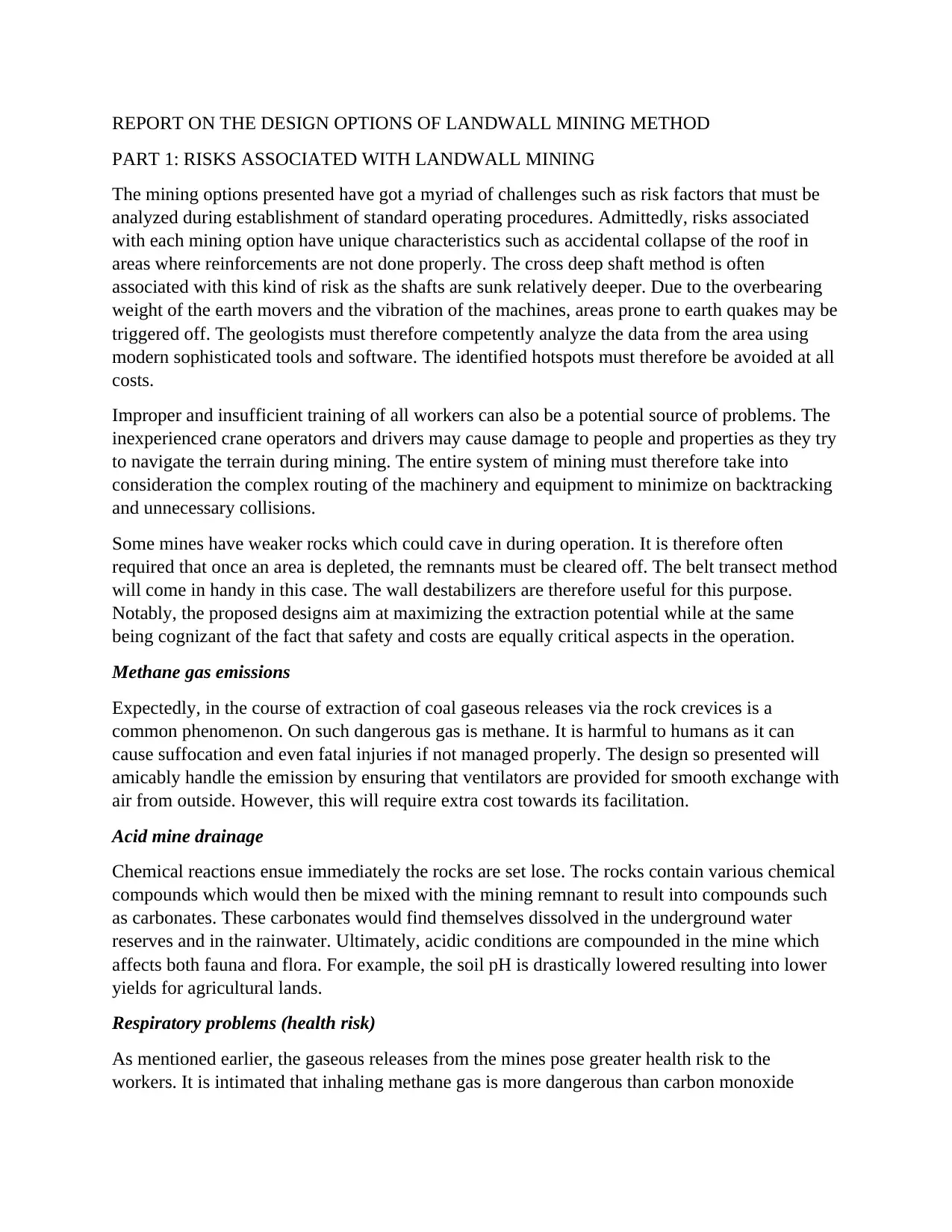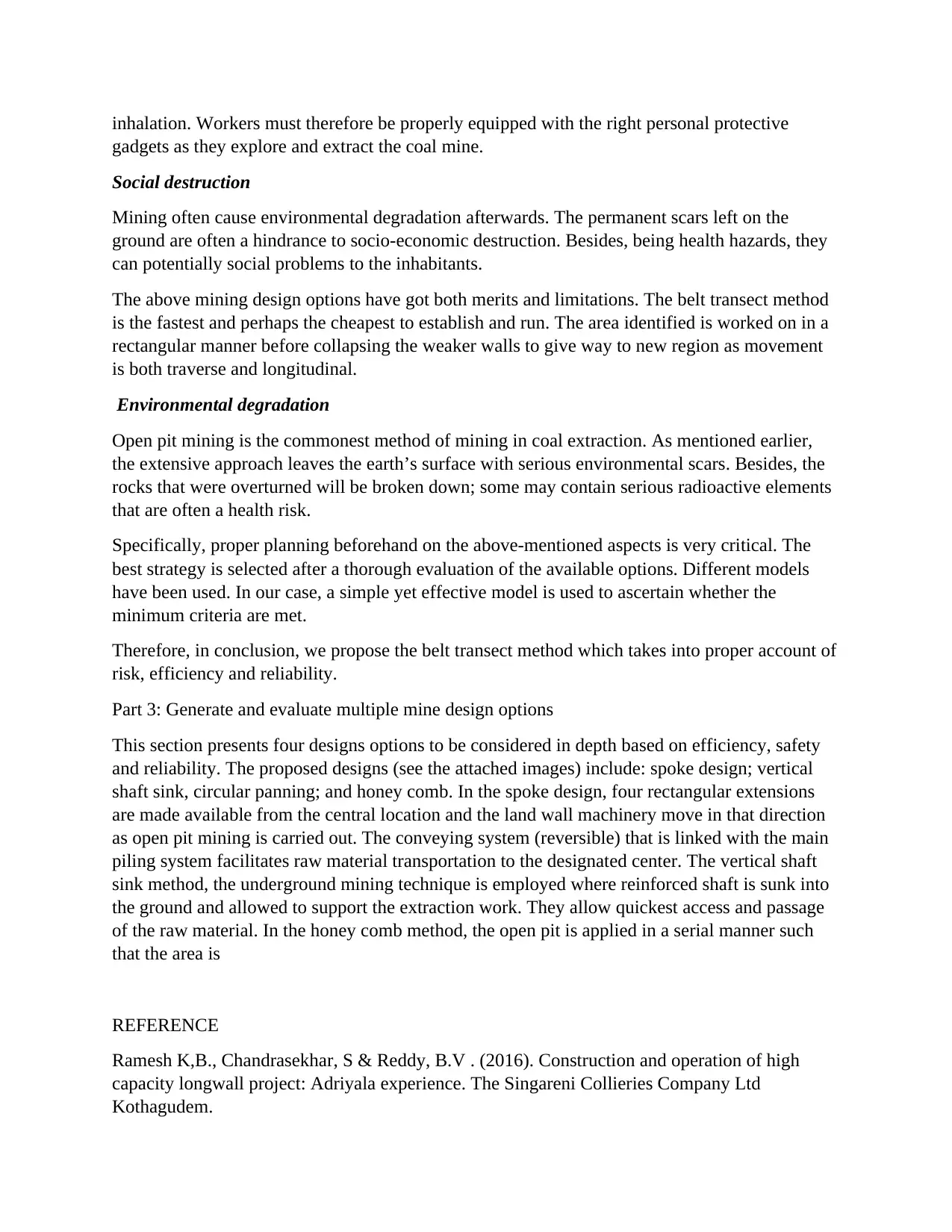Landwall Mining Method Design Options
VerifiedAdded on 2020/02/24
|3
|995
|57
AI Summary
This assignment explores the various design options for landwall mining, focusing on minimizing risks and maximizing efficiency. It delves into the potential hazards associated with different mining techniques, such as methane gas emissions, acid mine drainage, and respiratory problems. The report evaluates four specific designs: spoke, vertical shaft sink, circular panning, and honeycomb, considering their safety, reliability, and operational efficiency. A thorough risk analysis and comparison of these options are presented to recommend the most suitable approach for landwall mining.
Contribute Materials
Your contribution can guide someone’s learning journey. Share your
documents today.

REPORT ON THE DESIGN OPTIONS OF LANDWALL MINING METHOD
PART 1: RISKS ASSOCIATED WITH LANDWALL MINING
The mining options presented have got a myriad of challenges such as risk factors that must be
analyzed during establishment of standard operating procedures. Admittedly, risks associated
with each mining option have unique characteristics such as accidental collapse of the roof in
areas where reinforcements are not done properly. The cross deep shaft method is often
associated with this kind of risk as the shafts are sunk relatively deeper. Due to the overbearing
weight of the earth movers and the vibration of the machines, areas prone to earth quakes may be
triggered off. The geologists must therefore competently analyze the data from the area using
modern sophisticated tools and software. The identified hotspots must therefore be avoided at all
costs.
Improper and insufficient training of all workers can also be a potential source of problems. The
inexperienced crane operators and drivers may cause damage to people and properties as they try
to navigate the terrain during mining. The entire system of mining must therefore take into
consideration the complex routing of the machinery and equipment to minimize on backtracking
and unnecessary collisions.
Some mines have weaker rocks which could cave in during operation. It is therefore often
required that once an area is depleted, the remnants must be cleared off. The belt transect method
will come in handy in this case. The wall destabilizers are therefore useful for this purpose.
Notably, the proposed designs aim at maximizing the extraction potential while at the same
being cognizant of the fact that safety and costs are equally critical aspects in the operation.
Methane gas emissions
Expectedly, in the course of extraction of coal gaseous releases via the rock crevices is a
common phenomenon. On such dangerous gas is methane. It is harmful to humans as it can
cause suffocation and even fatal injuries if not managed properly. The design so presented will
amicably handle the emission by ensuring that ventilators are provided for smooth exchange with
air from outside. However, this will require extra cost towards its facilitation.
Acid mine drainage
Chemical reactions ensue immediately the rocks are set lose. The rocks contain various chemical
compounds which would then be mixed with the mining remnant to result into compounds such
as carbonates. These carbonates would find themselves dissolved in the underground water
reserves and in the rainwater. Ultimately, acidic conditions are compounded in the mine which
affects both fauna and flora. For example, the soil pH is drastically lowered resulting into lower
yields for agricultural lands.
Respiratory problems (health risk)
As mentioned earlier, the gaseous releases from the mines pose greater health risk to the
workers. It is intimated that inhaling methane gas is more dangerous than carbon monoxide
PART 1: RISKS ASSOCIATED WITH LANDWALL MINING
The mining options presented have got a myriad of challenges such as risk factors that must be
analyzed during establishment of standard operating procedures. Admittedly, risks associated
with each mining option have unique characteristics such as accidental collapse of the roof in
areas where reinforcements are not done properly. The cross deep shaft method is often
associated with this kind of risk as the shafts are sunk relatively deeper. Due to the overbearing
weight of the earth movers and the vibration of the machines, areas prone to earth quakes may be
triggered off. The geologists must therefore competently analyze the data from the area using
modern sophisticated tools and software. The identified hotspots must therefore be avoided at all
costs.
Improper and insufficient training of all workers can also be a potential source of problems. The
inexperienced crane operators and drivers may cause damage to people and properties as they try
to navigate the terrain during mining. The entire system of mining must therefore take into
consideration the complex routing of the machinery and equipment to minimize on backtracking
and unnecessary collisions.
Some mines have weaker rocks which could cave in during operation. It is therefore often
required that once an area is depleted, the remnants must be cleared off. The belt transect method
will come in handy in this case. The wall destabilizers are therefore useful for this purpose.
Notably, the proposed designs aim at maximizing the extraction potential while at the same
being cognizant of the fact that safety and costs are equally critical aspects in the operation.
Methane gas emissions
Expectedly, in the course of extraction of coal gaseous releases via the rock crevices is a
common phenomenon. On such dangerous gas is methane. It is harmful to humans as it can
cause suffocation and even fatal injuries if not managed properly. The design so presented will
amicably handle the emission by ensuring that ventilators are provided for smooth exchange with
air from outside. However, this will require extra cost towards its facilitation.
Acid mine drainage
Chemical reactions ensue immediately the rocks are set lose. The rocks contain various chemical
compounds which would then be mixed with the mining remnant to result into compounds such
as carbonates. These carbonates would find themselves dissolved in the underground water
reserves and in the rainwater. Ultimately, acidic conditions are compounded in the mine which
affects both fauna and flora. For example, the soil pH is drastically lowered resulting into lower
yields for agricultural lands.
Respiratory problems (health risk)
As mentioned earlier, the gaseous releases from the mines pose greater health risk to the
workers. It is intimated that inhaling methane gas is more dangerous than carbon monoxide
Secure Best Marks with AI Grader
Need help grading? Try our AI Grader for instant feedback on your assignments.

inhalation. Workers must therefore be properly equipped with the right personal protective
gadgets as they explore and extract the coal mine.
Social destruction
Mining often cause environmental degradation afterwards. The permanent scars left on the
ground are often a hindrance to socio-economic destruction. Besides, being health hazards, they
can potentially social problems to the inhabitants.
The above mining design options have got both merits and limitations. The belt transect method
is the fastest and perhaps the cheapest to establish and run. The area identified is worked on in a
rectangular manner before collapsing the weaker walls to give way to new region as movement
is both traverse and longitudinal.
Environmental degradation
Open pit mining is the commonest method of mining in coal extraction. As mentioned earlier,
the extensive approach leaves the earth’s surface with serious environmental scars. Besides, the
rocks that were overturned will be broken down; some may contain serious radioactive elements
that are often a health risk.
Specifically, proper planning beforehand on the above-mentioned aspects is very critical. The
best strategy is selected after a thorough evaluation of the available options. Different models
have been used. In our case, a simple yet effective model is used to ascertain whether the
minimum criteria are met.
Therefore, in conclusion, we propose the belt transect method which takes into proper account of
risk, efficiency and reliability.
Part 3: Generate and evaluate multiple mine design options
This section presents four designs options to be considered in depth based on efficiency, safety
and reliability. The proposed designs (see the attached images) include: spoke design; vertical
shaft sink, circular panning; and honey comb. In the spoke design, four rectangular extensions
are made available from the central location and the land wall machinery move in that direction
as open pit mining is carried out. The conveying system (reversible) that is linked with the main
piling system facilitates raw material transportation to the designated center. The vertical shaft
sink method, the underground mining technique is employed where reinforced shaft is sunk into
the ground and allowed to support the extraction work. They allow quickest access and passage
of the raw material. In the honey comb method, the open pit is applied in a serial manner such
that the area is
REFERENCE
Ramesh K,B., Chandrasekhar, S & Reddy, B.V . (2016). Construction and operation of high
capacity longwall project: Adriyala experience. The Singareni Collieries Company Ltd
Kothagudem.
gadgets as they explore and extract the coal mine.
Social destruction
Mining often cause environmental degradation afterwards. The permanent scars left on the
ground are often a hindrance to socio-economic destruction. Besides, being health hazards, they
can potentially social problems to the inhabitants.
The above mining design options have got both merits and limitations. The belt transect method
is the fastest and perhaps the cheapest to establish and run. The area identified is worked on in a
rectangular manner before collapsing the weaker walls to give way to new region as movement
is both traverse and longitudinal.
Environmental degradation
Open pit mining is the commonest method of mining in coal extraction. As mentioned earlier,
the extensive approach leaves the earth’s surface with serious environmental scars. Besides, the
rocks that were overturned will be broken down; some may contain serious radioactive elements
that are often a health risk.
Specifically, proper planning beforehand on the above-mentioned aspects is very critical. The
best strategy is selected after a thorough evaluation of the available options. Different models
have been used. In our case, a simple yet effective model is used to ascertain whether the
minimum criteria are met.
Therefore, in conclusion, we propose the belt transect method which takes into proper account of
risk, efficiency and reliability.
Part 3: Generate and evaluate multiple mine design options
This section presents four designs options to be considered in depth based on efficiency, safety
and reliability. The proposed designs (see the attached images) include: spoke design; vertical
shaft sink, circular panning; and honey comb. In the spoke design, four rectangular extensions
are made available from the central location and the land wall machinery move in that direction
as open pit mining is carried out. The conveying system (reversible) that is linked with the main
piling system facilitates raw material transportation to the designated center. The vertical shaft
sink method, the underground mining technique is employed where reinforced shaft is sunk into
the ground and allowed to support the extraction work. They allow quickest access and passage
of the raw material. In the honey comb method, the open pit is applied in a serial manner such
that the area is
REFERENCE
Ramesh K,B., Chandrasekhar, S & Reddy, B.V . (2016). Construction and operation of high
capacity longwall project: Adriyala experience. The Singareni Collieries Company Ltd
Kothagudem.

Singh, R.N., Pathan , A.G. & Unver, B. (no year). design of rib pillars in longwall mining based
on theoretical and practical approaches. Available from:
http://www.maden.org.tr/resimler/ekler/17c0907e67d868b_ek.pdf
on theoretical and practical approaches. Available from:
http://www.maden.org.tr/resimler/ekler/17c0907e67d868b_ek.pdf
1 out of 3
Your All-in-One AI-Powered Toolkit for Academic Success.
+13062052269
info@desklib.com
Available 24*7 on WhatsApp / Email
![[object Object]](/_next/static/media/star-bottom.7253800d.svg)
Unlock your academic potential
© 2024 | Zucol Services PVT LTD | All rights reserved.


